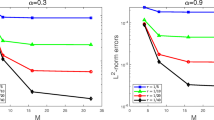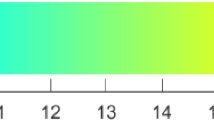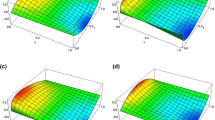Abstract
The shifted fractional trapezoidal rule (SFTR) with a special shift is adopted to construct a finite difference scheme for the time-fractional Allen–Cahn (tFAC) equation. Some essential key properties of the weights of SFTR are explored for the first time. Based on these properties, we rigorously demonstrate the discrete energy decay property and maximum-principle preservation for the scheme. Numerical investigations show that the scheme can resolve the intrinsic initial singularity of such nonlinear fractional equations as tFAC equation on uniform meshes without any correction. Comparison with the classic fractional BDF2 and L2-1\(_\sigma \) method further validates the superiority of SFTR in solving the tFAC equation. Experiments concerning both discrete energy decay and discrete maximum-principle also verify the correctness of the theoretical results.



Similar content being viewed by others
Data Availability
The data that support the findings of this study are available from the corresponding author, upon reasonable request.
References
Al-Maskari, M., Karaa, S.: The time-fractional Cahn-Hilliard equation: analysis and approximation. IMA J. Numer. Anal. 42(2), 1831–65 (2021)
Alikhanov, A.A.: A new difference scheme for the time fractional diffusion equation. J. Comput. Phys. 280, 424–438 (2015)
Allen, S.M., Cahn, J.W.: A microscopic theory for antiphase boundary motion and its application to antiphase domain coarsening. Acta Metall. 27(6), 1085–1095 (1979)
Anderson, D.M., McFadden, G.B., Wheeler, A.A.: Diffuse-interface methods in fluid mechanics. Annu. Rev. Fluid Mech. 30(1), 139–165 (1998)
Bu, W., Xiao, A., Zeng, W.: Finite difference/finite element methods for distributed-order time fractional diffusion equations. J. Sci. Comput. 72(1), 422–441 (2017)
Chen, L., Zhang, J., Zhao, J., Cao, W., Wang, H., Zhang, J.: An accurate and efficient algorithm for the time-fractional molecular beam epitaxy model with slope selection. Comput. Phys. Commun. 245, 106842 (2019)
Chen, S., Shen, J., Zhang, Z., Zhou, Z.: A spectrally accurate approximation to subdiffusion equations using the log orthogonal functions. SIAM J. Sci. Comput. 42(2), A849–A877 (2020)
Du, Q., Yang, J., Zhou, Z.: Time-fractional Allen-Cahn equations: analysis and numerical methods. J. Sci. Comput. 85(2), 42 (2020)
Gao, G., Sun, Z.: A compact finite difference scheme for the fractional sub-diffusion equations. J. Comput. Phys. 230(3), 586–595 (2011)
Hou, D., Xu, C.: Highly efficient and energy dissipative schemes for the time fractional Allen-Cahn equation. SIAM J. Sci. Comput. 43(5), A3305–A3327 (2021)
Hou, D., Xu, C.: A second order energy dissipative scheme for time fractional \(L^2\) gradient flows using SAV approach. J. Sci. Comput. 90(1), 25 (2022)
Hou, D., Zhu, H., Xu, C.: Highly efficient schemes for time-fractional Allen-Cahn equation using extended SAV approach. Numer. Algorithm. 88, 1077–1108 (2021)
Hou, T., Tang, T., Yang, J.: Numerical analysis of fully discretized Crank-Nicolson scheme for fractional-in-space Allen-Cahn equations. J. Sci. Comput. 72(3), 1214–1231 (2017)
Huang, C., Stynes, M.: Optimal \(H^1\) spatial convergence of a fully discrete finite element method for the time-fractional Allen-Cahn equation. Adv. Comput. Math. 46(4), 63 (2020)
Ji, B., Liao, H., Gong, Y., Zhang, L.: Adaptive linear second-order energy stable schemes for time-fractional Allen-Cahn equation with volume constraint. Commun. Nonlinear Sci. Numer. Simul. 90, 105366 (2020)
Jia, J., Zhang, H., Xu, H., Jiang, X.: An efficient second order stabilized scheme for the two dimensional time fractional Allen-Cahn equation. Appl. Numer. Math. 165, 216–231 (2021)
Jiang, S., Zhang, J., Zhang, Q., Zhang, Z.: Fast evaluation of the Caputo fractional derivative and its applications to fractional diffusion equations. Commun. Comput. Phys. 21(3), 650–678 (2017)
Jin, B., Lazarov, R., Zhou, Z.: Numerical methods for time-fractional evolution equations with nonsmooth data: a concise overview. Comput. Methods Appl. Mech. Engrg. 346, 332–358 (2019)
Jin, B., Li, B., Zhou, Z.: Numerical analysis of nonlinear subdiffusion equations. SIAM J. Numer. Anal. 56(1), 1–23 (2018)
Kopteva, N.: Error analysis of the L1 method on graded and uniform meshes for a fractional-derivative problem in two and three dimensions. Math. Comp. 88(319), 2135–2155 (2019)
Li, C., Yi, Q.: Finite difference method for two-dimensional nonlinear time-fractional subdiffusion equation. Fract. Calc. Appl. Anal. 21(4), 1046–1072 (2018)
Li, D., Sun, W., Wu, C.: A novel numerical approach to time-fractional parabolic equations with nonsmooth solutions. Numer. Math. Theory Methods Appl. 14(2), 355–376 (2021)
Li, D., Zhang, J., Zhang, Z.: Unconditionally optimal error estimates of a linearized Galerkin method for nonlinear time fractional reaction-subdiffusion equations. J. Sci. Comput. 76(2), 848–866 (2018)
Li, M., Zhao, J., Huang, C., Chen, S.: Nonconforming virtual element method for the time fractional reaction-subdiffusion equation with non-smooth data. J. Sci. Comput. 81(3), 1823–1859 (2019)
Li, M., Zhao, J., Huang, C., Chen, S.: Conforming and nonconforming VEMs for the fourth-order reaction-subdiffusion equation: a unified framework. IMA J. Numer. Anal. 42(3), 2238–300 (2021)
Liao, H., Tang, T., Zhou, T.: A second-order and nonuniform time-stepping maximum-principle preserving scheme for time-fractional Allen-Cahn equations. J. Comput. Phys. 414, 109473 (2020)
Liao, H., Tang, T., Zhou, T.: An energy stable and maximum bound preserving scheme with variable time steps for time fractional Allen-Cahn equation. SIAM J. Sci. Comput. 43(5), A3503–A3526 (2021)
Liao, H., Zhu, X., Wang, J.: The variable-step L1 scheme preserving a compatible energy law for time-fractional Allen-Cahn equation. Numer. Math. Theor. Meth. Appl. 15(4), 1128–1146 (2022)
Liu, F., Yang, C., Burrage, K.: Numerical method and analytical technique of the modified anomalous subdiffusion equation with a nonlinear source term. J. Comput. Appl. Math. 231(1), 160–176 (2009)
Liu, H., Cheng, A., Wang, H., Zhao, J.: Time-fractional Allen-Cahn and Cahn-Hilliard phase-field models and their numerical investigation. Comput. Math. Appl. 76(8), 1876–1892 (2018)
Liu, Y., Yin, B., Li, H., Zhang, Z.: The unified theory of shifted convolution quadrature for fractional calculus. J. Sci. Comput. 89(1), 18 (2021)
Lubich, C.: Discretized fractional calculus. SIAM J. Math. Anal. 17(3), 704–719 (1986)
Mohebbi, A., Abbaszadeh, M., Dehghan, M.: A high-order and unconditionally stable scheme for the modified anomalous fractional sub-diffusion equation with a nonlinear source term. J. Comput. Phys. 240, 36–48 (2013)
Quan, C., Tang, T., Yang, J.: How to define dissipation-preserving energy for time-fractional phase-field equations. CSIAM Tran. Appl. Math. 1(3), 478–490 (2020)
Shao, D., Rappel, W.J., Levine, H.: Computational model for cell morphodynamics. Phys. Rev. Lett. 105(10), 108104 (2010)
Shen, J., Tang, T., Yang, J.: On the maximum principle preserving schemes for the generalized Allen-Cahn equation. Commun. Math. Sci. 14(6), 1517–1534 (2016)
Stynes, M.: Too much regularity may force too much uniqueness. Fract. Calc. Appl. Anal. 19(6), 1554–1562 (2016)
Stynes, M., O’Riordan, E., Gracia, J.L.: Error analysis of a finite difference method on graded meshes for a time-fractional diffusion equation. SIAM J. Numer. Anal. 55(2), 1057–1079 (2017)
Tang, T., Yu, H., Zhou, T.: On energy dissipation theory and numerical stability for time-fractional phase-field equations. SIAM J. Sci. Comput. 41(6), A3757–A3778 (2019)
Xu, C., Prince, J.L.: Snakes, shapes, and gradient vector flow. IEEE Trans. Image Process. 7(3), 359–369 (1998)
Yin, B., Liu, Y., Li, H.: Necessity of introducing non-integer shifted parameters by constructing high accuracy finite difference algorithms for a two-sided space-fractional advection-diffusion model. Appl. Math. Lett. 105, 106347 (2020)
Yin, B., Liu, Y., Li, H., Zhang, Z.: Two families of second-order fractional numerical formulas and their applications to fractional differential equations. Fract. Calc. Appl. Anal. (2023). https://doi.org/10.1007/s13540-023-00172-1
Yin, B., Liu, Y., Li, H., Zhang, Z.: Efficient shifted fractional trapezoidal rule for subdiffusion problems with nonsmooth solutions on uniform meshes. BIT Numer. Math. 62(2), 631–66 (2021)
Zhang, H., Yang, X., Xu, D.: An efficient spline collocation method for a nonlinear fourth-order reaction subdiffusion equation. J. Sci. Comput. 85(1), 7 (2020)
Zhao, J., Xiao, J., Ford, N.J.: Collocation methods for fractional integro-differential equations with weakly singular kernels. Numer. Algorithm. 65(4), 723–743 (2014)
Acknowledgements
The authors are grateful to two anonymous referees and editors for their valuable suggestions which improve the presentation of this work greatly.
Funding
This work is supported by the Natural Science Foundation of Inner Mongolia Autonomous Region of China (No. 2021BS01003 to G.Z.), NSF of China (Nos. 12171177 and 12011530058 to C.H., 12201322 to B.Y.).
Author information
Authors and Affiliations
Corresponding author
Ethics declarations
Conflict of interest
The authors declare that they have no conflict of interest.
Additional information
Publisher's Note
Springer Nature remains neutral with regard to jurisdictional claims in published maps and institutional affiliations.
Rights and permissions
Springer Nature or its licensor (e.g. a society or other partner) holds exclusive rights to this article under a publishing agreement with the author(s) or other rightsholder(s); author self-archiving of the accepted manuscript version of this article is solely governed by the terms of such publishing agreement and applicable law.
About this article
Cite this article
Zhang, G., Huang, C., Alikhanov, A.A. et al. A High-Order Discrete Energy Decay and Maximum-Principle Preserving Scheme for Time Fractional Allen–Cahn Equation. J Sci Comput 96, 39 (2023). https://doi.org/10.1007/s10915-023-02263-w
Received:
Revised:
Accepted:
Published:
DOI: https://doi.org/10.1007/s10915-023-02263-w




